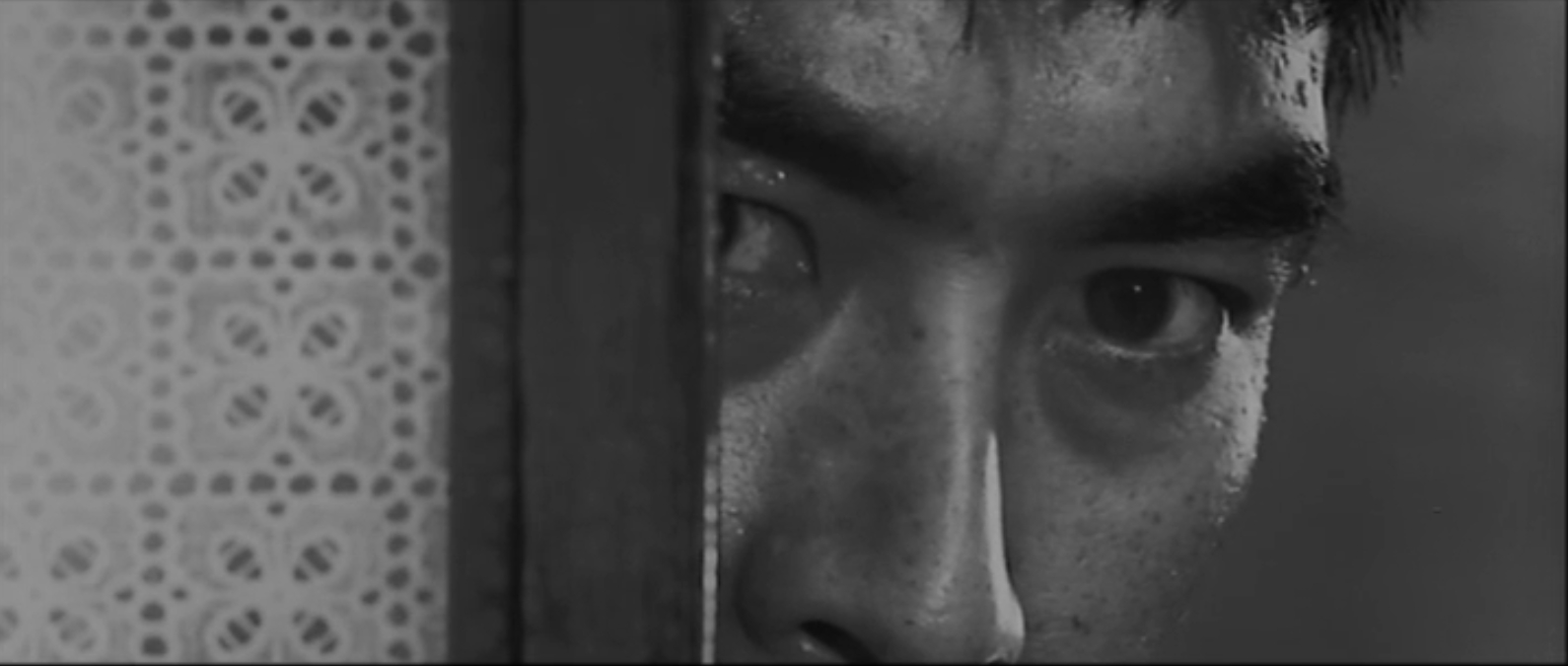A brilliant opening. It’s past eleven o’clock in the night. At Yokohama station, still full of people. Two detectives are running to catch a train, already starting out from the platform. It is bound for Kagoshima, the furthest prefecture to the south. The train is full of passengers, brightly lit, humid and hot. They can’t find any vacant seat, so they crouch on the floor. Unpleasant. The train blasts through the dark veil of the night. It won’t be apparent as to why this opening is so significant until much, much later, but this is brilliant. Just a brilliant opening.
Harikomi was one of the earliest Seicho Matsumoto‘s works to be adapted into a film, and probably one of the best of all visual adaptations so far. Screenplay was by Shinobu Hashimoto, who had been working with Kurosawa in previous years (Rashomon, Seven Samurai, Ikiru and others). Some complain the long, repetitive mechanics of surveillance police work, but I find it more rhythmic and atmospheric at the same time. The greatest advantage of the film is its contemporaneousness. The film was made in 1957 (released in 1958), which was only a few years after the novel had been published. Most of the elements in the film, even the additional episodes, characters or locations not in the original novel (Matsumoto’s original is only 10 pages or so) lends authenticity to the work. Every tiny detail, even a shot of a few seconds long, becomes an essential building block of this tale of the lost hope.

Two detectives, Yugi and Shimooka, from Tokyo Metropolitan Police investigating a murder of a pawn shop owner in Meguro, visits a small, sleepy town of Saga in Kyushu island, more than 1,000 km far from the scene of the crime. They masquerade themselves as salesmen and stay in a cheap lodging. Across the narrow alley from this cheap lodging is an ordinary looking house. The detectives keep keen eyes on the woman of the house. She was an old sweetheart of Ishii, the prime suspect of the murder. It seems a slim chance, but they bet on the desperate murderer on the run showing up to see the old sweetheart, who is now married to a stingy bank teller.

This film is worth seeing just for Hideko Takamine‘s performance. She plays a woman whose daily existence has been reduced to almost zero, thanks to her husband. He is a kind of person who thinks marriage is nothing but hiring a maid. You can see her vacant look, dead eyes and lifeless breathing, even from afar, through the telephoto lens of voyeurs. Her performance here is all the more incredible and devastating because of jubilating transformation in the last thirty minutes.

There are many fascinating scenes involving the detectives shadowing Takamine’s character. On one occasion, we are watching two detectives almost bored with humdrum of her daily routines. They holed up in the room on the second floor with the large opening, looking down every movement in the house across the alley. The camera was on the detective Shimooka eating his lunch in the room. Then Detective Yugi alerts him. She is apparently going somewhere. In one great camera movement, we are transferred from the staled air of the room to the woman in her kimono in the brightest summer daylight. From there on, it is a wild chase. And landscape of this little trip suggests the world she lives in is of desolation and full of dead ends.
The reason I think the opening of this film brilliant rests on the question “why did these detectives take the train from Yokohama, not from Tokyo?” Remember, these detectives are from Tokyo Metropolitan Police Department, so it would have been more natural for them to take such a long-range train from Tokyo, instead of from Yokohama. The reason, as the detectives tell the other fellow detectives, is to avoid newspaper reporters. These reporters would never miss their rabbits taking a train in Tokyo station bound for the edge of the country, especially when the rabbits are chasing a murder suspect. That tells us how the world turns around Tokyo for them. Yokohama is only less than an hour ride from Tokyo, but the world doesn’t care for it. The murderer on the run, Ishii, was also attracted to this center of the world, dreaming he could make good, if he grabbed a chance in the big city. Of course it didn’t happen. He sank into the bottom of the urban society, where poverty and filth were abundant. Would the guy have been happier if he had stayed at home with his sweetheart? The original story and the film are ambiguous about this alternative as well. The couple we see at the end may be too naive, too powerless and too fragile. I imagined, nobody told them to be strong. Nobody told them they could be strong.

Harikomi aka Stakeout (張込み, 1958)
Directed by Yoshitaro Nomura
Screenplay by Shinobu Hashimoto, based on the novel by Seicho Matsumoto
Cinematography by Seiji Inoue
Music by Toshiro Mayuzumi
Starring Minoru Ooki, Seiji Miyaguchi, Hideko Takamine
Shochiku
Copyrighted materials, if any, on this web page are included as “fair use”. These are used for the purpose of research, review or critical analysis, and will be removed at the request of copyright owner(s).

